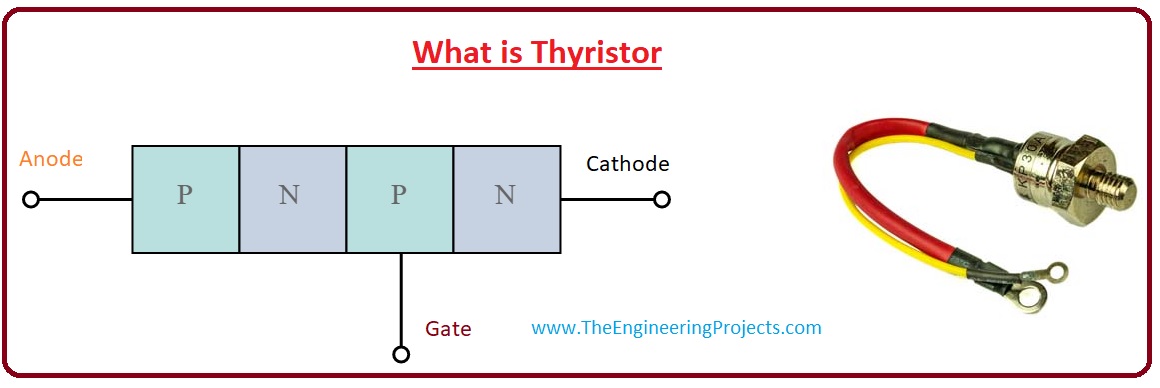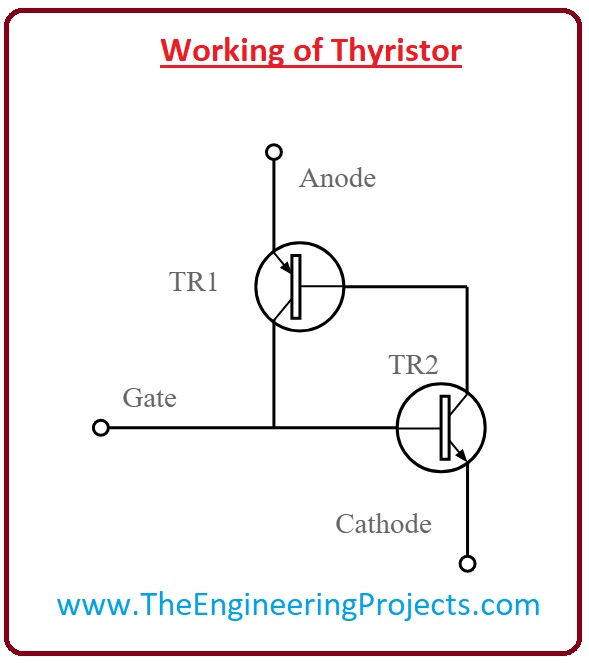
What is Thyristor
- A thyristor is also known as SCR (silicon controlled rectifiers) used in different switching circuits like a transistor and in power controlling circuitry.
- The physical structure of this semiconductor is different than the other semiconductors materials like transistor that has three layers but in thyristor 4 layers of different elements are constructed.
- In a normal transistor, there are 3 P, N, P or N, P, N layer exists but in while in thyristor four-layer like P, N, P, N exists.
- Its 'P' end is known as anode and 'N' end is known as the cathode. As in normal transistor base control terminal in this device, the control terminal is known as a gate that is adjacent to the cathode.
- This module can be created with the different semiconductor materials but normal it is manufactured with the silicon.
- As the silicone has the ability to handle larger amperes current and voltage easily as well it has ability to bear high temperature so it mostly preferred for thyristor construction.
- with these features, its price and construction are simple so it prefered for thyristor and some other electronic devices.

Working of Thyristor
- The working of this module is different than other semiconductors device, to the understanding of working of this device we draw the equivalent circuit.
- In the given figure you can see that two transistors are linked with one another the first transistor is NPN that is behaving like the anode and the second transistor is PNP that is behaving like the cathode.
- If we provide input supply to at the terminals of thyristor there will be no current passes as the both of transistor ane unbiased state.
- If we connect input supply at the gate then current will passes through the base that will operate the TR2 transistor.
- When TR2 starts its operation than the base of the first transistor get force from this transistor and start its operation it causes to put TR2 in working state either we separated the input supply.

Features of Thyristor
- These are some features of thyristor that are described here with detailed.
Specifications Parameters dI/dt Extreme increment of on-state current It is an extreme value of current for on condition if it surpasses then our device will be damaged. IGM Maximum Gate Current It is the extreme value at the gate that it can bear. IGT Triggering current of the gate It is the triggering value of current at the gate that also starts to current flow through anode and cathode terminals of component. I2t Overcurrent protection The I2t parameter tells about the value of fuse used for this module. IT(AV) On condition average current This parameter of thyristor explains about the average value of current passing through the module.
Types of Thyristor
- There are numerous types of thyristor according to their use and structure.
- One important feature of thyristor is that it stops current to flow in reverse direction so if we add and diode then current starts to flow in the opposite direction. This type of arrangement is known as RCT or reverse conducting thyristor.
- During reverse operation both thyristor and diode not operate at the same time but they take some time for the operation that provides protection from overheating.
- This type of thyristor used in inverter circuits and frequency regulators.
- This types of thyristor are used in such applications where fast switching needs. For this process in certain cases, negative polarity voltage also provided to the gate.
- To control the voltage at cathode and anode terminals negative voltage at the gate control the minorities carriers.
- The physical construction of thyristor is like to normal thyristor but the difference is that the area of cathode that enhances the controlling capability of the gate.
- It is also known switch for a gate of thyristor. This types of thyristor are not normally used in circuits because they not operate at reverse voltage.
- In such circuits where there is no use reverse voltage and no need of rectifier circuit this type of thyristor is used. These are normally used in switching circuits.
Applications of Thyristor
- The thyristor is normally used in different electronic circuits and devices, its some practical uses are explained here with the detailed.
- It used in different electrical devices for the controlling of alternating current at the input such as motor, light etc.
- It used in different circuits as a switch.
- In a different circuit, it used to control the overvoltage.
- It used in different controllers as a trigger.
- It also used in camera for flashing of a photograph.



